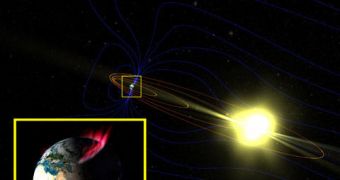Investigations conducted with a constellation of NASA spacecraft have shown that particles produced in our planet's atmosphere by events known as substorms tend to get accelerated by Earth's magnetic field as they head towards the planetary surface.
Astrophysicists and atmospheric scientists have known that speedy particles exist high above our heads for quite some time. Yet, it was only now that they managed to gain some additional insight into their origins and behavior.
“Substorms” developed in the planet's magnetic field are the origin of these particles. They are basically rater powerful energy outburst, which produce a large amounts of electrons.
As they rocket towards the surface, these particles gain a lot of energy, and contribute to supercharging such manifestations as the Aurora Borealis (the northern lights). In the new study, experts were able to discover precisely how these particles are accelerated.
Apparently, after they are first generated in substorms, the particles pass a relatively large number of changing magnetic fields, which contribute individually to changing their energy levels.
This discovery was made by analyzing data obtained from the THEMIS satellite constellation, which the American space agency operates specifically for this type of studies. The mission's name is an acronym for Time History of Events and Macroscale Interactions during Substorms.
The spacecraft, launched back in 2007, were flown to orbit so that they understand the source and movement particles of particles such as these spontaneously produced electrons, Space reports.
Doing so could allow experts to predict space weather with increased accuracy, in turn helping safeguard communication satellites and the lives of astronauts on the International Space Station (ISS).
“The origin of fast electrons in substorms has been a puzzle. It hasn't been clear until now if they got their burst of speed in the middle of the storm or from some place further away,” says expert and study team member Maha Ashour-Abdalla.
He was also the lead author of the new investigation. The scientist holds an appointment at the University of California in Los Angeles (UCLA).
“For 30 years, one of the questions about the magnetic environment around Earth has been: How do magnetic fields give rise to moving, energetic particles'?” asks NASA Goddard Space Flight Center study co-author Melvyn Goldstein.
The expert is the chief of the Geospace Physics Laboratory at the GSFC, in Greenbelt, Maryland. The research team made the discovery after modeling THEMIS data in a new computer simulation.
“This research shows the great science that can be accomplished when modelers, theorists and observationalists join forces,” says GSFC THEMIS deputy project scientist, Larry Kepko.
“THEMIS continues to yield critical insights into the dynamic processes that produce the space weather that affects Earth,” he concludes.

 14 DAY TRIAL //
14 DAY TRIAL //